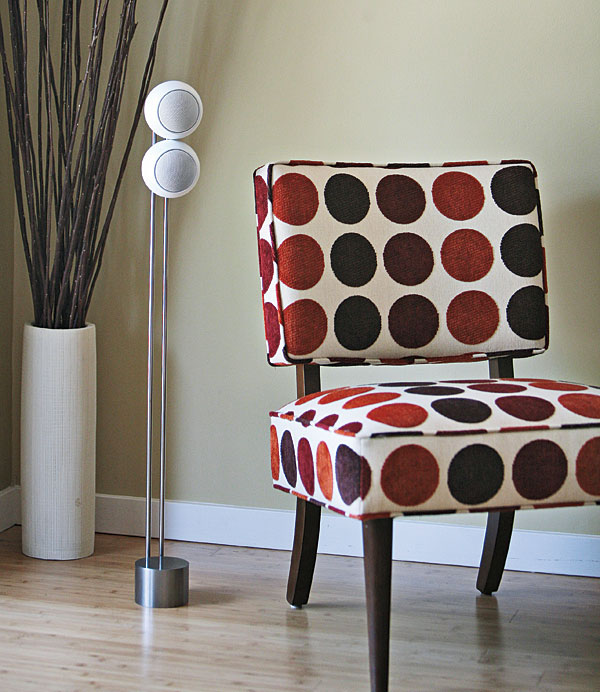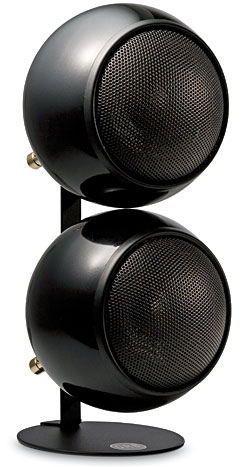Both the Nucleus and the A'Diva (either in regular or Ti) use a single full-range driver, either conventional plastic or made from titanium.
Orb Audio People’s Choice Speaker System

At A Glance: Dual orbs in front, single orbs behind • Full-range drivers in steel enclosures • Rod or pedestal stand
Spherical loudspeakers are perhaps too easily dismissed: “Oh look, it’s round. Cute gimmick. Next…” That box speakers are easy to build certainly doesn’t guarantee sound quality. In fact, designers of quality speakers are constantly rebelling against the limitations of rectangular enclosures. To curb cabinet resonance, designers build bracing into the box and stuff the interior with damping material. They curve the sides to stop standing waves from developing between parallel walls. But rather than tweak boxes, some do away with them altogether. So if you think the spherical steel shells of Orb Audio’s People’s Choice satellite speakers are mere gimmicks, think again.
We last considered Orb Audio with a review of its Mod1 speaker system in 2005 that was briefly updated online three years later. Since then, the company’s product line has expanded to include several surround systems based on varying combinations of single-sphere, dual-sphere, and quad-sphere speakers. The original Mod1 system ($798) has five single-sphere Mod1s. The Mod1 PLUS system ($999) upgrades the center to the dual-sphere Mod2. The People’s Choice system ($1,098) reviewed here uses Mod2s across the three front channels and Mod1s for surrounds. Moving up the line, the Mod2 system ($1,289) uses Mod2s all around. The Mod4 People’s Choice system ($1,999) goes to quad-sphere Mod4s for the three front channels and Mod2s in back. Five matched Mod4s form the top-of-the-line Mod4 system ($2,239). These package prices include the 8-inch, 200-watt Super Eight subwoofer, or add $300 to upgrade to the 10-inch, 300-watt Uber Ten.

Lighten Up
I don’t often remark on the visual impact of a speaker system in
my listening room, but in this case, it was noteworthy. The little Orbs—so much smaller and rounder than my reference speakers—actually made the room feel larger and less cluttered. I could see more of the wall behind them. I hadn’t realized the extent to which my chunky speakers added an increment
of everyday stress. But I sure noticed when that source of
stress disappeared. No doubt
the slender rods of the stands contributed to this visual and psychological lightening.
So what’s inside that sweet-looking sphere? Just one full-range driver with a 3-inch polypropylene cone. This distinguishes the Orbs from two-way spherical speakers—such as the Gallo Nucleus and Morel SoundSpot—which use coaxially mounted drivers with the tweeter inside the woofer. The sonic advantage of the Orb approach is it eliminates the tweeter/woofer crossover and any quirks it might introduce in frequency response. In the rear are gold-plated, spring-loaded binding posts that accept fairly skinny zip cord—the company recommends 16-gauge for short runs and something slightly thicker for longer ones.
 Orb’s various stand and mount options include the HOSS (Hunk Of Solid Steel) stand used for the review system’s front channels ($318/pair) and the TOSS (Tube Of Sculpted Steel) stands used in the rear ($218/pair). The HOSS has two rods rising from a base of solid steel, as the name promises. The base’s round footprint is only 4 inches, but it is so extraordinarily heavy that the expected tipping hazard is not as great as you’d think. In fact, with the steel-grilled Orbs fixed to the stand, this combination of speaker and stand is probably more likely to survive being knocked over than a conventional box speaker and stand. The TOSS has a single hollow rod arcing from a flat base with a larger 6x8-inch footprint. Its elegant curved column is best admired from the side.
Orb’s various stand and mount options include the HOSS (Hunk Of Solid Steel) stand used for the review system’s front channels ($318/pair) and the TOSS (Tube Of Sculpted Steel) stands used in the rear ($218/pair). The HOSS has two rods rising from a base of solid steel, as the name promises. The base’s round footprint is only 4 inches, but it is so extraordinarily heavy that the expected tipping hazard is not as great as you’d think. In fact, with the steel-grilled Orbs fixed to the stand, this combination of speaker and stand is probably more likely to survive being knocked over than a conventional box speaker and stand. The TOSS has a single hollow rod arcing from a flat base with a larger 6x8-inch footprint. Its elegant curved column is best admired from the side.
The Super Eight subwoofer has an 8-inch driver with a bottom-firing port in a cube that is 12 inches on all sides. It includes a bypass to facilitate using the crossover in your receiver. However, in this case, you may be better off using the sub’s continuous crossover dial to fine-tune it, which is what I ended up doing.
Associated equipment for this review included a Pioneer Elite VSX-53 A/V receiver and a Panasonic DMP-BD87P Blu-ray player. (My Oppo BDP-83 was in the shop to fix a sticky disc drawer but will make a comeback soon.) All movie demos were Blu-ray Discs with DTS-HD Master Audio soundtracks.
Airy, Not Beamy
It was impossible to listen to the Orbs for more than a
few seconds without becoming aware of their strong suits: clarity and openness. They threw out a clearly defined
and delightfully airy soundfield, one that remained consistent when I moved way off-axis, and the full-range drivers were not at all beamy. Vertical and horizontal dispersion were equally strong—I could stand up, sprawl on the floor, or move around the sofa without missing a word of dialogue. In the absence of a cheap, metal tweeter, high frequencies were mercifully free of ringing. Midrange was strong in the presence region, but not abrasively etched, and had an impressive continuity, perhaps a result of the passive, crossoverless satellite design.
The active crossover between speakers and sub, however, took some dialing in. Like many compact sat/sub sets, the People’s Choice set requires a high crossover point, placing more of the midbass-making burden on the sub. The manufacturer recommends a crossover of 100 to 120 hertz. After much experimentation at those settings, I was still hearing a big gap in bass frequencies between speakers and sub. Pushing the crossover setting to 150 Hz finally closed the gap. That makes subwoofer placement even more critical than it ordinarily would be—you’ll want to keep the sub as near to the front satellites as possible to ensure the bottom-to-top continuity of male voices and other elements residing on both sides of the crossover frequency.
The British gangster thriller London Boulevard gave the Orbs a chance to reiterate their clarity in several ways. One was low-level resolution. In a quiet, outdoor, nighttime conversation, whispering street sounds gently enveloped the seating area. The speakers could also resolve simultaneous events without masking, like a snatch of soundtrack music cutting through the noise of a crowded pub.
- Log in or register to post comments


With my Onkyo receiver Audyssey set the crossover frequency at 150 and I had the subwoofer's crossover disabled because of that. Your review suggests to me that I am slightly confused over this issue.
thelrdintexas
For the last two years I have used the Orbs with 4 mods for center channel, 2 mods eacg for left and right front, 2 mods each for rear and 1 mod each for front high, right and left.
I have been very pleased with their sound.

































































